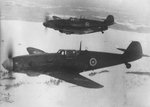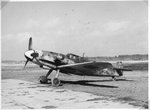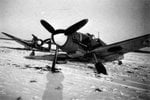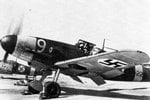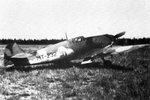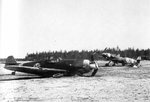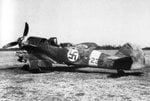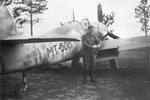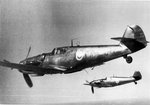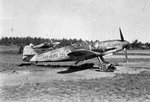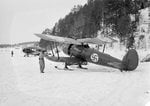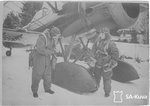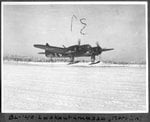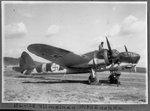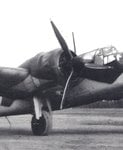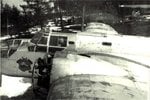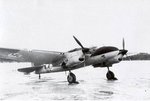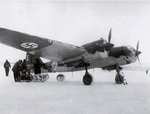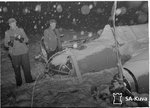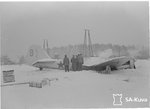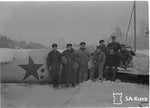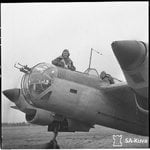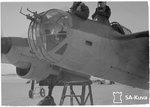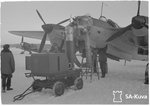- Thread starter
- #41
The journey to get the Messerschmitt Me-109s to Finland started on the 10th of February 1943 and took one month. The first seventeen pilots to ferry the fighters to Finland were: Ehrnrooth, Lahtela, Ervi, Puhakka, Pekuri, Euramo, Pokela, Tervo, Myllylä, Lehtonen, Nyholm, Juutilainen, Tuominen, Fräntilä, Lönnfors, Mäittälä and Peltola. The Finnish team traveled by air with a DC-2 from Helsinki to Berlin and from there to Werneuchen Air Base close to Berlin for Messerschmitt conversion training. Pokela was hurt during the conversion training, when the engine of his Me-109 caught fire at 200 m altitude after a touch-and-go landing and he had to make a forced landing. He had to be flown to Finland in the transport plane. "Manu" Fräntilä flew during the next three weeks 1 h 25 min with the Me-109E and 2 h 30 min with the Me-109G. The Germans had planned for more training, but the leader of the group, squadron commander Maj. Erkki "Immeli" Ehrnrooth thought that they had already spent enough time at Werneuchen and it was time to move on. In the beginning of March the Finnish team traveled by rail to Vienna and arrived there on the 9th of March 1943. The Finns waited a few days in Vienna for the word from the large Messerschmitt factory at Wiener-Neustadt that the fighters for Finland were ready for the acceptance test flights. The Finns flew the test flights over the Alps with great scenery.
The Finnish group took of from Wiener-Neustadt on the 10th of March 1943 and headed to Breslau. All aircraft had not been test-flown and the plan was that if there were any trouble with them they should land after circling the airfield. All fighters worked well so the group headed to the first destination. The Finns flew in four independent four-ship groups led by Ehrnrooth, Ervi, Lahtela and Puhakka. The visibility deteriorated immediately after takeoff and Fräntilä noticed that his fuel tanks weren't as full as they were supposed to be. They strayed left from their course and found a divert field short of their destination. With red "fuel low" lights on Fräntilä and Nyholm landed Rosenborn airfield, refueled and took off for a 10 min flight to Schöngarten Air Base at Breslau and joined Lahtela and Euramo there. Also Puhakka's group had landed on the way for refueling. From Schöngarten the groups flew via Thorn and Königsberg to Riga. When they took off from Riga Capt. Lahtela's canopy opened and his leather flight jacket was lost. The group landed at Riga to fix the aircraft and to fish Lahtela's jacket from the sea. They couldn't fix the canopy and so Lahtela, Ervi and Euramo stayed at Riga until March 14. On the 13th of March 1943 thirteen Messerschmitt Me-109-G-2s landed at Helsinki Malmi airfield.
The Finnish group took of from Wiener-Neustadt on the 10th of March 1943 and headed to Breslau. All aircraft had not been test-flown and the plan was that if there were any trouble with them they should land after circling the airfield. All fighters worked well so the group headed to the first destination. The Finns flew in four independent four-ship groups led by Ehrnrooth, Ervi, Lahtela and Puhakka. The visibility deteriorated immediately after takeoff and Fräntilä noticed that his fuel tanks weren't as full as they were supposed to be. They strayed left from their course and found a divert field short of their destination. With red "fuel low" lights on Fräntilä and Nyholm landed Rosenborn airfield, refueled and took off for a 10 min flight to Schöngarten Air Base at Breslau and joined Lahtela and Euramo there. Also Puhakka's group had landed on the way for refueling. From Schöngarten the groups flew via Thorn and Königsberg to Riga. When they took off from Riga Capt. Lahtela's canopy opened and his leather flight jacket was lost. The group landed at Riga to fix the aircraft and to fish Lahtela's jacket from the sea. They couldn't fix the canopy and so Lahtela, Ervi and Euramo stayed at Riga until March 14. On the 13th of March 1943 thirteen Messerschmitt Me-109-G-2s landed at Helsinki Malmi airfield.
Attachments
-
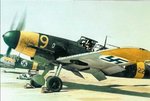 Messerschmitt Bf-109 001.jpg78.1 KB · Views: 657
Messerschmitt Bf-109 001.jpg78.1 KB · Views: 657 -
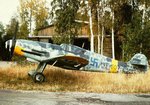 Messerschmitt Bf-109 002.jpg187.2 KB · Views: 1,442
Messerschmitt Bf-109 002.jpg187.2 KB · Views: 1,442 -
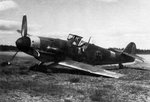 Messerschmitt Bf-109G2 001.jpg114.8 KB · Views: 1,122
Messerschmitt Bf-109G2 001.jpg114.8 KB · Views: 1,122 -
 Messerschmitt Bf-109G2 002.jpg103.6 KB · Views: 1,087
Messerschmitt Bf-109G2 002.jpg103.6 KB · Views: 1,087 -
 Messerschmitt Bf-109G2 003.jpg110.7 KB · Views: 293
Messerschmitt Bf-109G2 003.jpg110.7 KB · Views: 293 -
 Messerschmitt Bf-109G2 004.jpg117.8 KB · Views: 304
Messerschmitt Bf-109G2 004.jpg117.8 KB · Views: 304 -
 Messerschmitt Bf-109G2 005.jpg142.2 KB · Views: 1,382
Messerschmitt Bf-109G2 005.jpg142.2 KB · Views: 1,382 -
 Messerschmitt Bf-109G2 006.jpg103.2 KB · Views: 325
Messerschmitt Bf-109G2 006.jpg103.2 KB · Views: 325 -
 Messerschmitt Bf-109G2 007.jpg119 KB · Views: 259
Messerschmitt Bf-109G2 007.jpg119 KB · Views: 259 -
 Messerschmitt Bf-109G2 008.jpg111.4 KB · Views: 342
Messerschmitt Bf-109G2 008.jpg111.4 KB · Views: 342 -
 Messerschmitt Bf-109G2 009.jpg104.6 KB · Views: 278
Messerschmitt Bf-109G2 009.jpg104.6 KB · Views: 278 -
 Messerschmitt Bf-109G2 0010.jpg104.8 KB · Views: 306
Messerschmitt Bf-109G2 0010.jpg104.8 KB · Views: 306 -
 Messerschmitt Bf-109G2 0011.jpg89.1 KB · Views: 281
Messerschmitt Bf-109G2 0011.jpg89.1 KB · Views: 281 -
 Messerschmitt Bf-109G2 0012.jpg133 KB · Views: 1,386
Messerschmitt Bf-109G2 0012.jpg133 KB · Views: 1,386 -
 Messerschmitt Bf-109G2 0013.jpg121.9 KB · Views: 345
Messerschmitt Bf-109G2 0013.jpg121.9 KB · Views: 345 -
 Messerschmitt Bf-109G2 0014.jpg118.2 KB · Views: 352
Messerschmitt Bf-109G2 0014.jpg118.2 KB · Views: 352 -
 Messerschmitt Bf-109G2 0015.jpg71.5 KB · Views: 305
Messerschmitt Bf-109G2 0015.jpg71.5 KB · Views: 305
Last edited:

